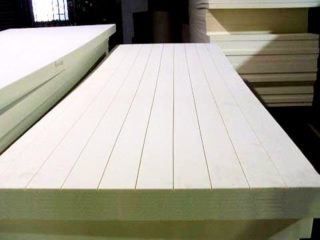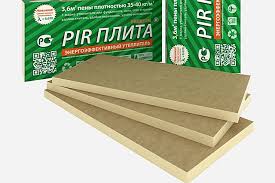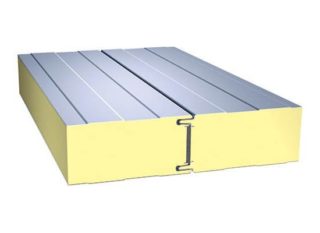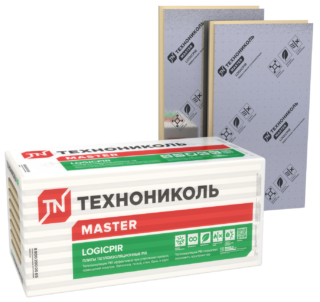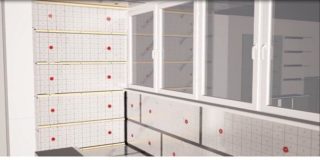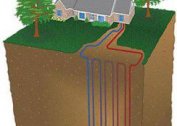The range of thermal insulation products is increasing every year. Manufacturers create new materials and improve the properties of the old, resulting in high-quality insulation with a convenient shape, performance characteristics. New heat insulators include PIR plates.
The chemical structure of the material
The insulation has the full name polyisocyanurate. It is similar in its properties to polyurethane foam, the differences are in the proportions of the starting materials and the use in the synthesis of catalytic additives. Also, production occurs at a different temperature regime. The output is a complex polymer with a ring molecular structure. Compared with polyurethane foam, PIR has increased resistance to heat transfer, chemical inertness and mechanical strength.
The insulation has a porous structure with a closed cell filled with gas. High thermal insulation properties are provided due to 5% polymer content and 95% gas filling. The polymer has high adhesion to various surfaces. This leads to difficulties during installation due to the stickiness of the material to all objects. For this reason, the plates are always coated on both sides with a protective layer, which also increases resistance to mechanical stress, UV rays and natural factors.
Varieties of insulation
PIR boards vary in filler material and thickness. The purpose of the insulation depends on these indicators.
The following types of coatings are distinguished:
- Kraft paper. It is used for insulation inside the building. It is an excellent basis for subsequent finishing.
- Fiberglass for linings. Also used for interior decoration and exterior wall insulation. Top may have a mineral coating.
- Fiberglass and bitumen impregnation. Used in roof insulation.
- Aluminum. It happens multilayer, smooth, with craft paper. Thanks to the reflective surface, thermal insulation properties are improved.
- Fiberglass with graphite components. Allows you to increase the resistance to open fire, which improves the fire properties of the entire structure.
- Panel sandwich with polyisocyanurate foam. They can perform bearing and warming functions at the same time. Actively used in industrial construction.
PIR boards are available in various sizes. The thickness should be minimal, since the material is expensive, while even a thin layer is able to qualitatively insulate the structure.
Plates are produced with smooth ends and a lock part. Thanks to the lock, you can make a seamless coating through which the cold will not penetrate.
Main characteristics
PIR insulation is considered one of the best heat insulators. This was made possible thanks to its characteristics.
- The thermal conductivity coefficient reaches 0.021 W / m * K. In real conditions, it can be slightly higher, in the range of 0.024-0.027 W / m × K, but its insulation properties do not get worse from this.
- Hygroscopicity and vapor permeability. Rigid enclosed cells of the structure do not pass water. Experiments show that moisture incapable will affect the quality of the material. The vapor permeability coefficient is 0.0015-0.015 mg / m * h * Pa.
- The average density due to the porosity of the structure. Fluctuates in the range of 20-50 kg / m3.It is convenient to work with the material; it retains its shape well throughout the entire life cycle. It does not shrink and withstands multiple compressive loads without severe loss of shape and strength. For additional strength, the plates are treated with other materials.
- Resistance to fire. When exposed to an open flame, the top layer is charred. Melting, spread of fire and fluidity does not occur. The lining also affects the combustibility group - plates with foil belong to the class G1, with kraft paper G2. At temperatures above 200 ° C, the material begins to crumble and lose its strength. It does not emit harmful toxic substances that can harm human health and the environment.
The thermal insulation properties of pir may vary slightly depending on the chosen lining material.
Advantages of a heat insulator
All physical, operational and technical characteristics of PIR boards can be attributed to the advantages. There are other positive qualities:
- Durability. The manufacturer declares that the thermal insulation service life of the feast may be 30 years or more.
- Wide range of permissible operating temperatures.
- The material is not susceptible to decay, has a high chemical resistance to aggressive compounds.
- Fungus and other parasites do not start in the plates, it is not suitable for creating nests for birds and is not interesting to rodents.
- Environmental friendliness. Due to its chemical stability, the insulation does not emit pollutants into the atmosphere.
- During installation, the plates do not dust and do not harm the skin of a person. The master may not use personal protective equipment for the respiratory tract and eyes during installation work.
The material also has drawbacks, due to which it is not widely distributed.
- Lack of information. Few home owners know about such a heater.
- High price. It is associated with the complex technology of manufacturing a heat insulator.
All these shortcomings will be eliminated over time, and PIR insulation will be actively used in installation and construction works.
Manufacturers
Russian companies are actively developing in the production of PIR panels. They offer a wide selection of quality products with different sizes and cover materials. The following Russian brands are among the most popular manufacturers:
- PirroGroup. The company has a head office in Moscow and production in Saratov. It produces one of the quality standard insulation materials based on polyisocyanurate foam, which is the main specialization. It offers pir heat-insulating boards with a thickness of 20 to 200 mm in increments of 10 mm. Any trim options are available.
- Profholod. Initially, the company was engaged in the manufacture of sandwich panels with polyurethane foam, but later their activities expanded. Since 2014, they produce PIR panels of various types. Now on sale are 8 items of material, which is also divided by thickness.
- Feast insulation TechnoNIKOL, producing the LOGICPIR line. It presents different types of plates for any application in professional and individual construction. There are narrowly targeted varieties that are called at the place of application - “wall”, “balcony”, “floor”. Insulation pir Technonikol is considered one of the most famous due to the popularity of the brand.
Due to the high cost of the plates, you need to carefully calculate all the necessary characteristics, sizes and thicknesses so as not to mistakenly buy the wrong insulation.
Any building construction must in total possess such heat transfer resistance that it is within the framework of established SNiP norms. These values depend on many factors - the region of residence, the purpose of the building, the place of construction.
Mounting Features
All types of insulation feasts have their own styling features and mounting methods. The material on the walls is traditionally taken with dimensions of 0.6 * 1.2 meters. The thickness depends on the area in which the insulation is created. Laying is done end-to-end with lock fastening of plates with each other. The material is fixed to the base on the dowels, after having previously applied the base to the surface of the adhesives.
The sandwich panels are also interlocked and blown with foam for tightness. Additionally, attachment points can be treated with glue. On the frame, the plates are fixed on sheet metal bolts.
Roof insulation is similar to a sandwich structure, but only one side is sheathed with a sheet. The laying structure is sealed due to the shape in the form of waves that overlap.
Thermal insulation for floors on all sides has a locking mechanism. Additional fasteners are not required.
